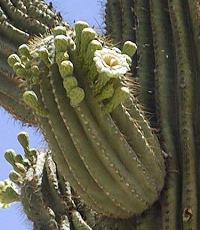Sunset®: 11-13,18-21
USDA: 9-10
Frost Tolerance: Adults are hardy to 14° F (-10°C), protect the seedlings from frost
Sun Exposure: Full sun
Origin: Sonoran desert of southwestern USA and Sonora state in Mexico
Growth Habits: Growing slowly to 50 feet (15 m); arms 12 to 27 in. in diameter (30-65 cm); 12 to 24 obtuse ribs, 0.4 to 1.2 in. tall (1-3 cm), areoles app. 1 inch apart (2.5 cm), with brown felt; longest spine can reach 2.8 in. long (7 cm).
Watering Needs: Saguaros grow mostly in winter and in late summer, this is when it should be watered more
Propagation: Seeds

It is difficult to talk about Arizona and not about Saguaro. The Saguaro grows very slowly. In the wild, it can take over 100 years to be tall enough for an arm to develop. In cultivation, with proper care, when planted outside in the proper climate, it can grow 8 inches a year (20 cm) or more.
The success rate in transplanting a mature saguaro can be low, if the transfer is not done by experienced nurserymen, this being said, a mature saguaro is a conversation piece.
Blooming Habits:
The Saguaro blooms in May to June. The flower bearing areoles are closer together and have denser yellowish acicular spines. The flowers open in the evening and stay open until mid day the following day, 4 to 4.8 inches long (10-12 cm), 3.6 to 4.8 inches in diameter (9-12 cm). Bats and doves are the main pollinators. The greenish to reddish edible fruit ripens a month later and can be eaten raw or made into jam and pastries. It has a red pulp and black seeds and when the fruit is half-eaten by the wild life, with the distance, it looks like a red flower.
Propagation:
The seeds are extremely small and the seedlings stay extremely small for several years. You can keep a small saguaro for years in a pot, before it grows too big.
Desert-Tropicals is dedicated to provide gardening advice, gardening ideas, and information about flower of all kind for landscape and collections.We try to check carefully the identification of the plants on the illustrations as well as the other information from the page, but occasionally errors do occur. if you notice anything that needs to be changed please contact us.Thanks.
© 1998-2020 Philippe Faucon, All Rights Reserved.
